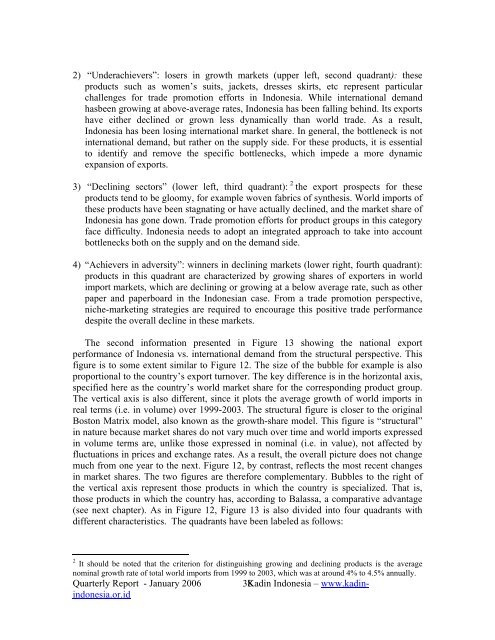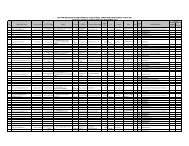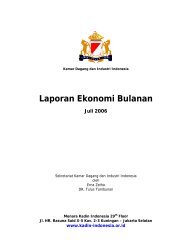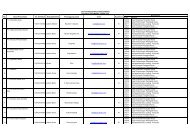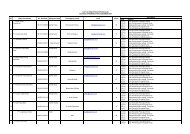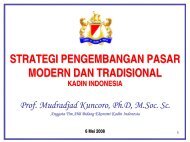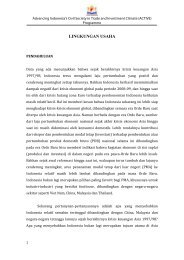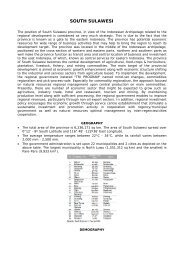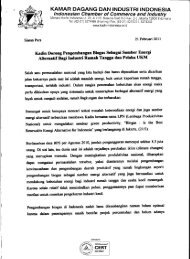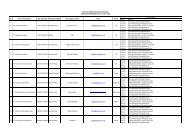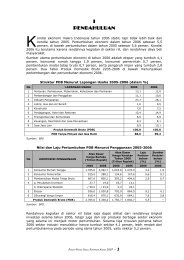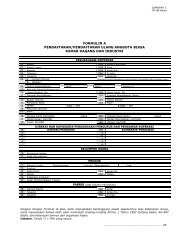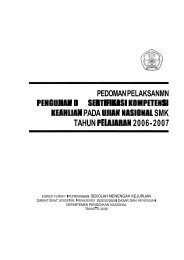Quarterly Report - Kadin Indonesia
Quarterly Report - Kadin Indonesia
Quarterly Report - Kadin Indonesia
Create successful ePaper yourself
Turn your PDF publications into a flip-book with our unique Google optimized e-Paper software.
2) “Underachievers”: losers in growth markets (upper left, second quadrant): theseproducts such as women’s suits, jackets, dresses skirts, etc represent particularchallenges for trade promotion efforts in <strong>Indonesia</strong>. While international demandhasbeen growing at above-average rates, <strong>Indonesia</strong> has been falling behind. Its exportshave either declined or grown less dynamically than world trade. As a result,<strong>Indonesia</strong> has been losing international market share. In general, the bottleneck is notinternational demand, but rather on the supply side. For these products, it is essentialto identify and remove the specific bottlenecks, which impede a more dynamicexpansion of exports.3) “Declining sectors” (lower left, third quadrant): 2 the export prospects for theseproducts tend to be gloomy, for example woven fabrics of synthesis. World imports ofthese products have been stagnating or have actually declined, and the market share of<strong>Indonesia</strong> has gone down. Trade promotion efforts for product groups in this categoryface difficulty. <strong>Indonesia</strong> needs to adopt an integrated approach to take into accountbottlenecks both on the supply and on the demand side.4) “Achievers in adversity”: winners in declining markets (lower right, fourth quadrant):products in this quadrant are characterized by growing shares of exporters in worldimport markets, which are declining or growing at a below average rate, such as otherpaper and paperboard in the <strong>Indonesia</strong>n case. From a trade promotion perspective,niche-marketing strategies are required to encourage this positive trade performancedespite the overall decline in these markets.The second information presented in Figure 13 showing the national exportperformance of <strong>Indonesia</strong> vs. international demand from the structural perspective. Thisfigure is to some extent similar to Figure 12. The size of the bubble for example is alsoproportional to the country’s export turnover. The key difference is in the horizontal axis,specified here as the country’s world market share for the corresponding product group.The vertical axis is also different, since it plots the average growth of world imports inreal terms (i.e. in volume) over 1999-2003. The structural figure is closer to the originalBoston Matrix model, also known as the growth-share model. This figure is “structural”in nature because market shares do not vary much over time and world imports expressedin volume terms are, unlike those expressed in nominal (i.e. in value), not affected byfluctuations in prices and exchange rates. As a result, the overall picture does not changemuch from one year to the next. Figure 12, by contrast, reflects the most recent changesin market shares. The two figures are therefore complementary. Bubbles to the right ofthe vertical axis represent those products in which the country is specialized. That is,those products in which the country has, according to Balassa, a comparative advantage(see next chapter). As in Figure 12, Figure 13 is also divided into four quadrants withdifferent characteristics. The quadrants have been labeled as follows:2 It should be noted that the criterion for distinguishing growing and declining products is the averagenominal growth rate of total world imports from 1999 to 2003, which was at around 4% to 4.5% annually.<strong>Quarterly</strong> <strong>Report</strong> - January 2006 38 <strong>Kadin</strong> <strong>Indonesia</strong> – www.kadinindonesia.or.id


